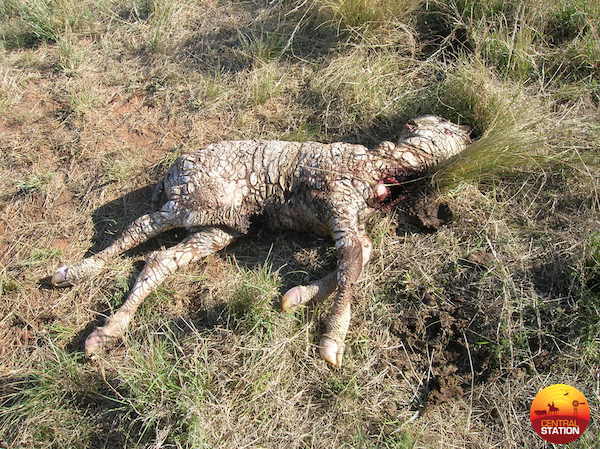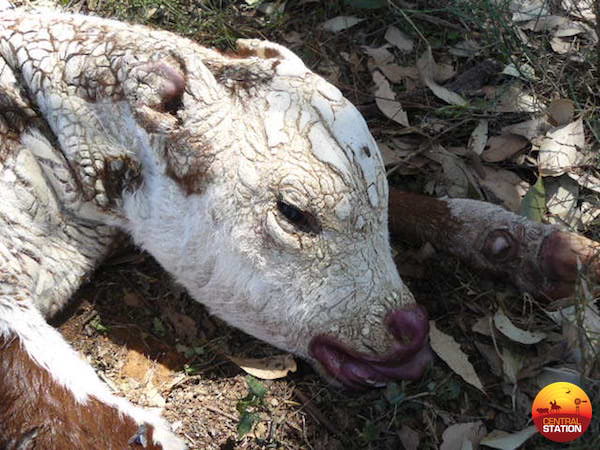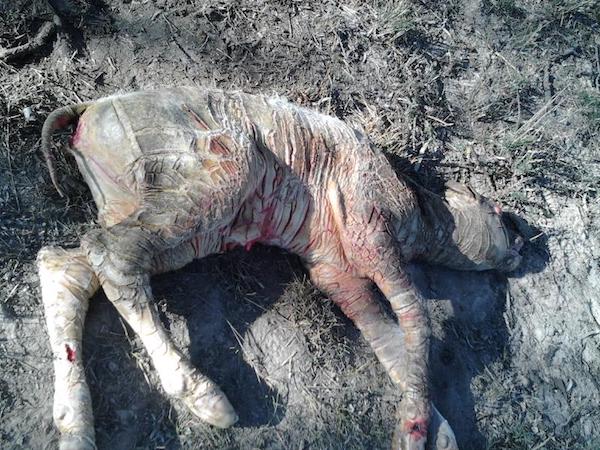When you hear the sound of Hoofbeats . . .
Host: Dr Jillian Kelly
Back in my uni days, we were told repeatedly “when you hear the sound of hoofbeats, look for horses, not zebras”. Meaning that in veterinary science, common things happen commonly, so look for the obvious answer.
Except for some days . . .
A few years ago, I received a call from a cattle station owner who reported having about six calves born dead, and that they looked “like they’ve got dam silt all over them”. This sounded pretty strange over the phone, so I jumped in the car and travelled the 260km out to take a look.
When I got there, I saw the strangest looking calves I’ve ever seen in my career to date. They weren’t covered in normal skin and hair but instead thick, white scales, with everted eyelids and lips and small curled up ears.
 Dead calves with fish scales.
Dead calves with fish scales.
 Close up picture of an affected calf.
Close up picture of an affected calf.
When in doubt – get the text book out. I pulled “Diseases of Cattle in Australasia” out of the toolbox in my car and turned to the section on Abortions and Stillbirths. There was a picture of a very similar calf with the words “Ichthyosis fetails or Fish Scale Disease – does not occur in Australia”. Hmm . . . I think I may be about to rewrite the textbook!
I was out of mobile range and could not ring anyone for advice, or the lab to guide my sample collection. So I took samples of everything I could think of – plenty of samples of the scales, plenty of photos, and blood and hair samples from the parents (who, incidentally, looked completely normal).
It turns out that this is the first recorded case of Ichthyosis fetalis in cattle in Australia. This disease is a genetic condition that results in a disorder of keratinisation of the skin, so there is excess keratin produced forming thick hard scales instead of normal skin.
 Ichthyosis fetalis in cattle – first recorded case in Australia.
Ichthyosis fetalis in cattle – first recorded case in Australia.
These calves needed to get one copy of the genetic condition from their mother and one from their father in order to show clinical signs of the disease. It turns out that this herd was significantly inbred – a common ancestor (probably a bull) carried the defect and passed it onto his progeny, which were then mated together to cause these spectacular dead calves. I ended up working on this case with a team of experts in this field from all over the world. Some of the samples that I collected ended up being sent to a university in Italy for genetic analysis, and the case is still in the process of being written up as a scientific paper.
So the moral of this story, is yes, common things do happen commonly but don’t disregard those zebra’s entirely. It’s true, most times when I am called out to investigate cases I do find mundane, run of the mill issues. But every now and then the diseases are really significant – they could be new to Australia, they could be notifiable or important to our export markets, or they could be devastating to the productivity of that cattle station if not recognised early. It’s so very important to look, check, and ask a vet!
